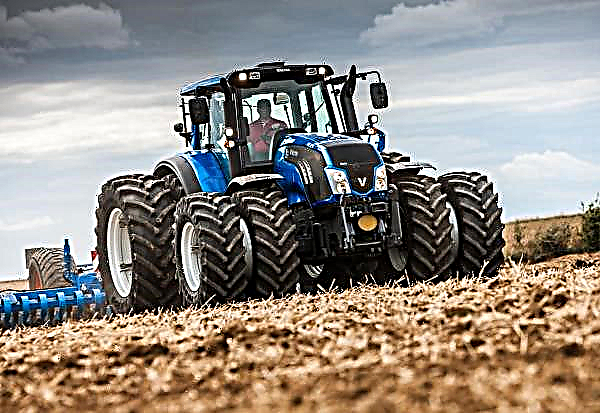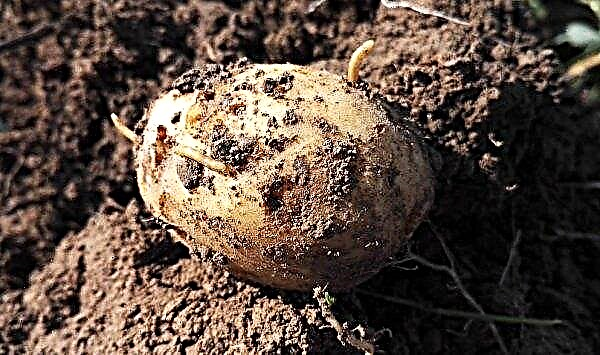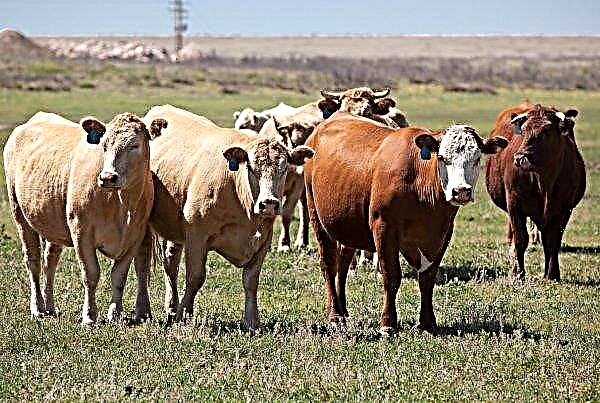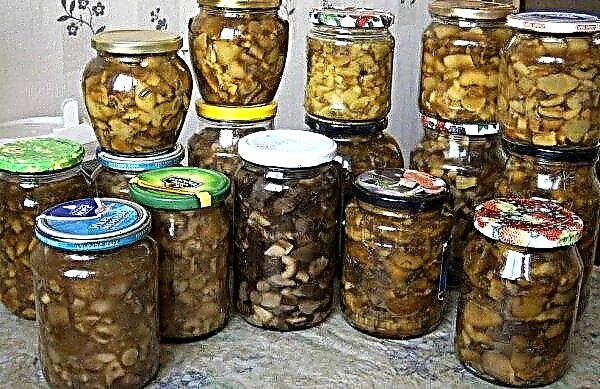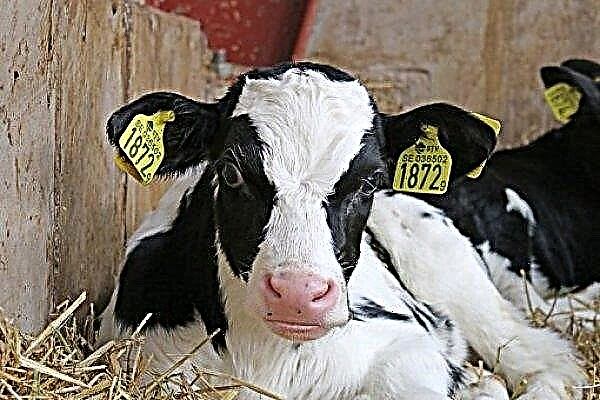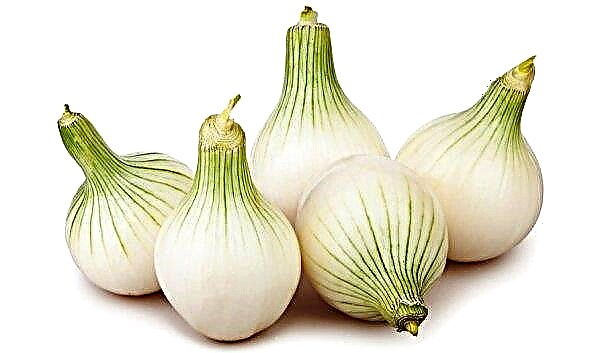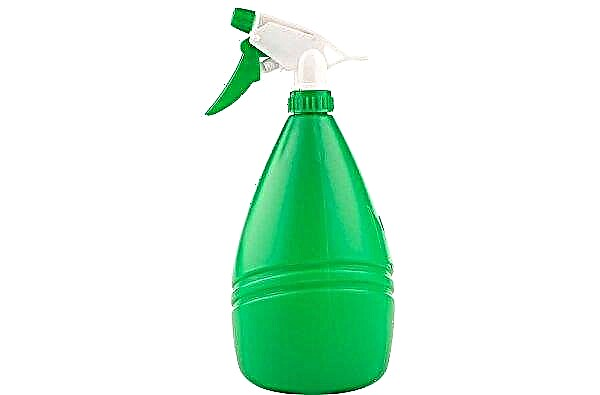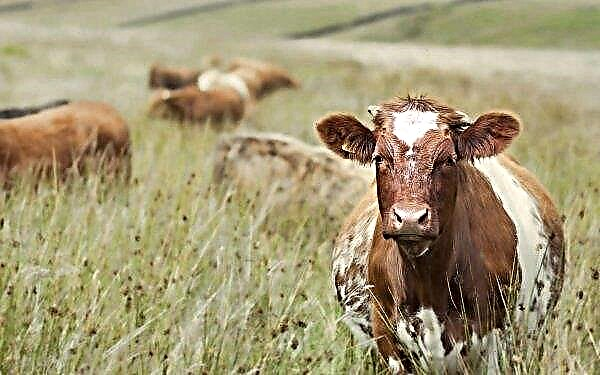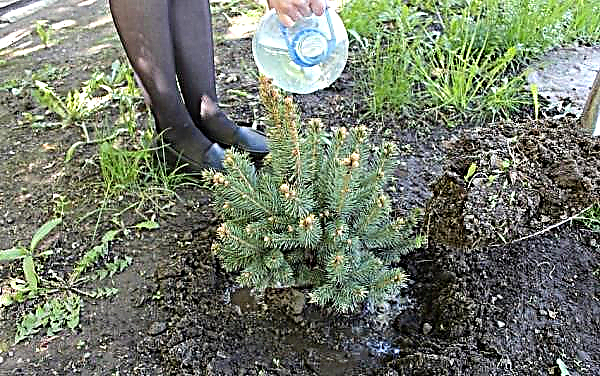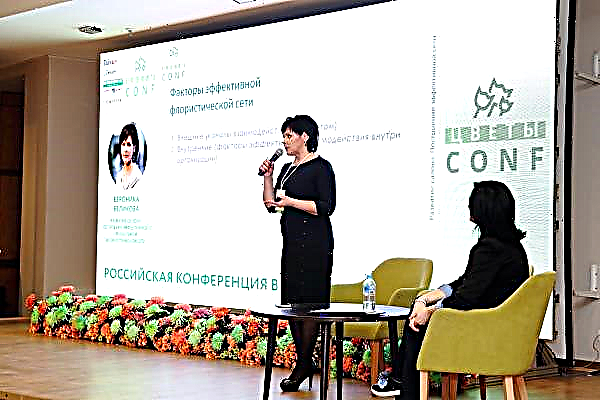Truffle red tomatoes first appeared on the shelves of domestic seed shops in 2002 and since then have firmly won the recognition of gardeners, the variety has gained a reputation as a reliable and productive tomato. In this article we will look at the characteristics of red truffle tomato, learn how to grow tomato seedlings, plant tomato bushes in the ground and take care of them until the crop ripens.
Characterization and description of the variety
Tomato red truffle seeds are offered by many well-known seed-growing organizations in Russia, such as Biotechnika, Siberian Garden and others. This variety is one of the varieties of the Japanese truffle tomato variety. On sale you can find tomato truffles with various colors of fruits: red, pink, yellow, orange, black. All of them have the same characteristics of bushes and fruits, with the exception of the colors of the tomatoes themselves.
Did you know? Tomatoes can have a different shape, depending on the variety. Tomatoes are: flat-rounded, spherical, pear-shaped, drop-shaped, elongated in the form of icicles, pepper-shaped.
Characteristics of the variety Truffle red:
- the variety is mid-season, the first fruits appear after 115–120 days;
- the height of the bushes varies from 1.70 to 2.0 m, depending on the growing conditions (higher in the greenhouse of the plant);
- in a brush of 5–6 fruits, a fruit brush is simple;
- on stems, the brushes are located through 2 sheets;
- red fruits, have the shape of a pear or nodule with a pronounced ribbing;
- medium-sized tomatoes, fruit weight - 90–170 g;
- the main purpose of the variety is conservation and salting;
- the average yield of a variety is 4 kg per plant, with full care, the potential yield is 8–10 kg.

Pros and cons of the variety
Like any tomato variety, Truffle red tomatoes have both undeniable advantages in the eyes of the consumer, and some disadvantages.
- Pros:
- fleshy, not watery fruits with a good taste;
- fruit brushes fit perfectly;
- convenient size, uniformity of fruits - important properties for winter harvesting;
- unpretentiousness in cultivation;
- dense structure of tomatoes, facilitating transportation over long distances;
- ability to long storage;
- good yield;
- tolerance to prolonged decrease in air temperature;
- resistance to certain diseases and pests.
Did you know? The color of tomato fruits depends on the cultivated variety. They can be: red, pink, white, yellow, orange, green, black, brown and even striped.
- Minuses:
- long-lasting green spot at the stalk;
- the need for regular pinching and bush formation;
- the requirement for systematic tying of branches during the summer;
- small sizes of fruits.
Features of growing tomato varieties
Since this variety is tall, it must be grown through seedlings. The need is explained by the fact that in our climate the Red Truffle sown in seeds in the ground cannot reach its full potential - it simply does not have enough time before the onset of cold weather.
Microclimate
The temperature in the room where tomato seedlings are grown should not fall below + 18 ° C and rise above + 22 ° C. This is due to the fact that at low temperatures, the plantings become sick with fungal diseases, and at high temperatures, the aboveground mass rapidly develops, to the detriment of the root system.

The seedlings grown at high temperatures have a thin, elongated stem and a pale, light green color. Being planted in the ground, such plants begin to hurt for a long time during adaptation, which significantly delays fruiting and reduces overall productivity.
High humidity in the nursery is also unacceptable, because it also provokes the development of fungal diseases. To reduce air humidity, the room is regularly ventilated at least twice a day. Young plants need good lighting, for this the pots are placed closer to the light source (on the windowsill). If this is not enough, artificial illumination of crops is additionally used.
Pay attention to such tall varieties of tomatoes as:
Seed sowing technology
Seeds are sown approximately 2–2.5 months before the estimated date of planting in the soil. For example, if the planting takes place in mid-May, then the sowing is carried out around March 1.
Sowing soil
The soil for growing seedlings can be purchased in garden stores or mixed independently, and these work must be done in advance, in the fall. Good soil for growing seedlings is obtained from equal parts of leafy soil, humus and peat crumbs. A few handfuls of sifted wood ash and coarse river sand are added to this soil mixture.

Soil disinfection
Since most viruses, pathogens of fungal and bacterial diseases, as well as harmful insects winter in the soil, it is recommended that the soil be sterilized before sowing.
Soil sterilization can be carried out in several ways:
- In the oven. Sprinkle the soil on a baking sheet with a layer not exceeding 10 cm and place in the oven. Warm up at + 250 ° C for 30 minutes. After the soil has cooled to room temperature, it is placed in pots and used for sowing tomato seeds.
- Freezing. In winter time (December-January), the soil is poured into the landing containers or boxes and put out on the street or on the balcony for freezing at temperatures below 0 ° C for a week or two. The same procedure can be carried out in the freezer, but for one or two small planting pots.
- Watering with boiling water. Pots of soil are installed in the bathroom, after which they are abundantly watered with freshly boiled water. A bath is needed as a tray to drain excess fluid. After the temperature of the soil becomes equal to room temperature, sowing work can be carried out.
- Watering with Manganese Solution. A pale pink solution of water and potassium permanganate is made (per 1 liter of water 1 g of manganese), the potted soil is abundantly watered. The disinfecting solution neutralizes bacteria and pathogens in the soil.
Landing tanks
Tomato seeds can be grown in various containers, the main thing is that their depth is not less than 10 cm and there are holes in the bottom to drain excess moisture. They can be made of wood, ceramics, glass, laminated cardboard. For one plant that has 4 true leaves, you need 0.5 l of the volume of the area for the full extension of the root system. This volume is enough for the plant to land in the ground.
Sowing Tomato Seeds
Presowing seed treatment:
- Disinfection. Seeds are soaked for half an hour in a dark pink solution of manganese and water. The disinfecting solution destroys pathogens located on the surface of the seeds. At the end of the procedure, the seeds are washed well under clean running water, dried to flow, or laid out on a damp cloth for germination.
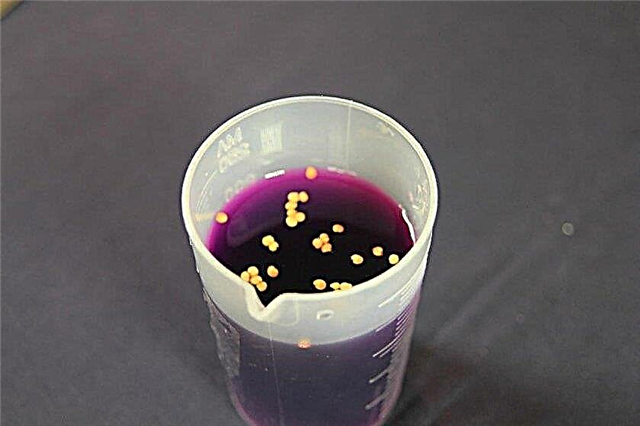
- Stimulation. After disinfection, the seeds can also be treated in growth stimulants. These substances contribute to the rapid germination of tomato seeds, and also provide them with vitamins and minerals. As growth stimulants, you can use both chemical stimulants purchased in garden centers, as well as natural ones derived from natural substances. Bee honey and aloe juice are very popular as natural growth stimulants. After processing in growth stimulants, the seeds are not washed under water, but immediately sown in the ground.
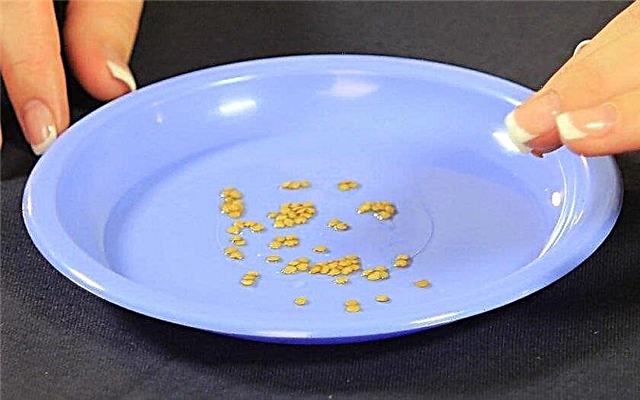
Sowing in individual containers:
- It is very convenient to use beer plastic glasses with a volume of 0.5 l as pots for growing.
- Before filling the soil, their bottom must be perforated with a metal nail heated over an open fire.
- In each pot, 2 seeds are sown to a depth of 1 cm, with a distance between seeds of 2 cm.
- After sowing, the soil in each pot is moderately watered (50 ml of water).
- Capacities with crops make up in one common large box, for example, a plastic one from under the fruits, after which they wrap it in polyethylene and install it in a warm place.
- The first sprouts will appear on about 5-7 days, the rate of germination depends on the temperature in the room. Pots with sprouted tomatoes are installed on the windowsill or on a special seedling table equipped with a phytolamp.
- After two real leaves are developed on the seedlings, the crops are thinned out and only one, the most developed tomato is left in each pot.
Important! Removing the extra seedling during thinning, do not pull it out with the roots, as this can damage the root system of a nearby tomato. It is most convenient to cut off an excess plant near the ground with the help of manicure scissors.
Sowing followed by picking:
- In this case, you can use a common seedling box. The requirements for it are the same as for individual containers: the height of the side is not lower than 10 cm and the drain holes in the bottom.
- The soil placed in a box is leveled, after which seedling furrows are marked and deepened. The furrow depth for sowing is 1–1.5 cm, the distance between the furrows is 10–15 cm (depending on the amount of seed). Seeds lay out each other at a distance of 2-3 cm. Sown furrows cover the soil and level the ground.
- After sowing, moderate watering is carried out so that the soil is slightly moistened, but no dirt is formed. The box is installed inside a large plastic bag or its surface is isolated from room air using a food-grade plastic film, which is very convenient for these purposes.
- After at least 1/10 of the crops appears on the surface of the soil, the box is rearranged closer to the light (on the windowsill, seedling table).
- Irrigation rules for seedlings growing in a common box are identical to irrigation rules for individual seedling containers. In the first 30 days after the appearance of young plants on the soil surface, watering should be minimal. In the last decade of March, when two pairs of true leaves appear on plants, the frequency of irrigation increases.
- As soon as the plants close in the aisles, they are dived into individual pots in which they will grow until they are planted in the soil.

Important! The soil in any seedling tank is poured so that its level is 1–2 cm did not reach the side. This is necessary for the convenience of irrigation seedlings.
Seedling Care
So that young seedlings do not get sick and grow healthy, she needs to create suitable conditions for growth:
- Lighting. Since the seedlings grown in the room lack the intensity of natural light, it must be artificially highlighted. To do this, next to the folding table or on the windowsill, a lamp is installed, equipped with a lamp having a daily radiation spectrum, or a special phytolamp. A lamp for plants is available at the flower shop. Additional lighting is included in the morning (from 8 to 10) and evening hours (from 16 to 18).
- Irrigation. In the first month of life, seedlings are watered as rarely as possible, after the top layer of soil has dried well. This is due to the fact that during this period, seedlings are very vulnerable to the development of a disease such as the black leg. This fungal disease is provoked by: increased soil moisture, insufficient lighting and cool air. Since the heating system is still operating in the houses in early spring, dry air contributes to the rapid drying of the soil in seedlings and provokes the need for frequent watering. You can reduce the need for irrigation by separating the windowsill with seedlings from the room with a polyethylene sheet attached to the walls on both sides of the window or by filling the soil in the root zone with mulch. As mulch seedlings, you can use finely chopped paper.
- Hardening. Young plants need hardening. For this, the seedlings growing in the room are ventilated using an open window 2 times a day (morning and evening). Ventilation reduces the temperature in the room, thereby creating the prerequisites for the hardening of plants. In February, the airing time is approximately 15 minutes; in the first half of March, the airing time is increased to 30 minutes.
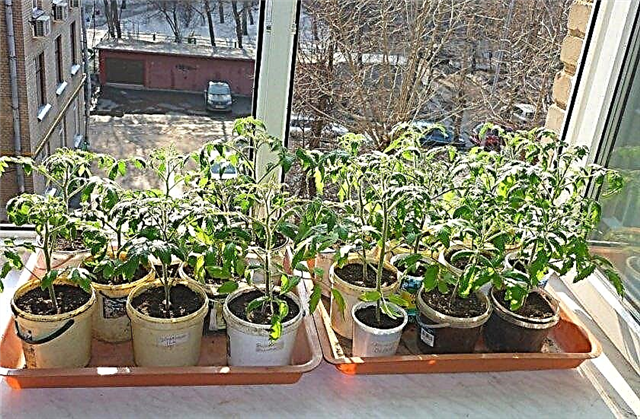 Since the second half of March, the plants have been aired already an hour twice a day. In April, the air warms up, and the heat on the street becomes stable, so in the first decade of April, street hardening of plants begins. For this, pots with seedlings are taken out to the street and set in partial shade. The first street hardening sessions do not exceed 30 minutes per day, with each day the duration of the procedures increases. After about 10 days, the plants can be on the street all day, they are brought into the room only at night. During street hardening, tomato seedlings in pots should never be placed in direct sunlight, i.e. immature plants can get sunburn. The most optimal place for them is partial shade under the protection of trees or shrubs.
Since the second half of March, the plants have been aired already an hour twice a day. In April, the air warms up, and the heat on the street becomes stable, so in the first decade of April, street hardening of plants begins. For this, pots with seedlings are taken out to the street and set in partial shade. The first street hardening sessions do not exceed 30 minutes per day, with each day the duration of the procedures increases. After about 10 days, the plants can be on the street all day, they are brought into the room only at night. During street hardening, tomato seedlings in pots should never be placed in direct sunlight, i.e. immature plants can get sunburn. The most optimal place for them is partial shade under the protection of trees or shrubs.
Planting seedlings in the ground
Planting tomatoes in open ground begins when the soil warms up to a depth of 30 cm. For the middle band, this period usually begins in mid-late May. The time for planting tomato seedlings varies depending on the region; in the northern regions, planting begins in early June, in the southern regions in early May. In an unheated greenhouse (with emergency heating), located in a region with a temperate climate, adult tomato seedlings are planted in mid-April.
Previously, before planting, prepare a bed for tomatoes. If the soil has been fertilized since autumn, then the bed is simply loosened, the soil is leveled and holes are made for planting tomatoes. If the earth needs fertilizers, then before loosening, nitrogen and phosphorus-potassium fertilizers are spread on the soil surface or organic matter is laid out (rotted bird droppings or last year's cattle manure). In this case, digging is carried out using a bayonet shovel, with a turn of the soil layer.Important! It is not recommended to plant non-seasoned seedlings in open ground: plants will be sick for a long time and get used to new conditions. The minimum hardening time on the street before landing in the ground is two weeks.
Experienced gardeners practice pre-planting processing of tomatoes on a leaf with insecticides from the Colorado potato beetle ("Karate", "Aktara"). This is justified, because at the time of planting tomato seedlings in the garden potatoes had not yet sprouted, and the overwintered Colorado beetle flies to the smell of tomato plants. Seedlings can simply be sprayed with an insecticide from a spray or dipped each plant in a bucket with the drug.

When planting tomato Truffle red, it is advisable to observe one of the planting schemes:
- First option. Plants are planted in two rows in compliance with the interval: between plants - 50 cm, between rows - 50 cm. Rows must be staggered in relation to each other. Every 2 rows a track is provided with a width of 70 cm, after which the landing pattern is repeated.
- The second option. Plants are planted in 4 rows in this order: the interval between plants is 50 cm, the interval between rows is 60 cm. The bushes in the rows should be staggered in relation to the plants in adjacent rows. After 4 rows of tomatoes, a track 120–150 cm wide is laid, after which the pattern repeats.
Landing:
- Seedlings in pots are taken out to the bed and placed near the holes.
- Watering the landing wells, based on each hole at least 2 liters of water.
- While the water is absorbed, the seedlings are carefully removed from the pot and installed in the holes, after which they fill the hole with soil so that a small depression forms in the root zone. This will make all subsequent irrigation more convenient, since the water will remain directly under the bush.
- Next, planted tomatoes are watered under the root, using 0.5 l of water per bush.
- The first 3 days of freshly planted seedlings, it is advisable to shade from the rays of the sun. To do this, you can use newspaper sheets, tree branches or cover the garden bed with a spunbond cloth, laying it on top of plants.
Features of tomato care
During the growing season, tomatoes require care, which consists of weeding, hilling, pinching, garter, watering and protection from diseases and harmful insects.
Feeding and watering
Tomatoes need to be watered every week, and in a particularly hot season, water more often: every 3 days. It is watered in the evenings, after 18 hours, at this time the daytime heat subsides and the air temperature drops significantly. They irrigate plants only at the root, tomatoes do not like sprinkling on the leaf, i.e. this provokes an outbreak of fungal diseases.

You can irrigate tomatoes with watering in the root zone or equip a tomato bed with a drip irrigation system. In the middle of the growing season, during fruit setting, tomatoes can be fed with potash fertilizers. In no case should you give tomato bushes top dressing containing nitrogen, causing rapid growth of leaves and stems.
Pasynkovka and formation of a bush
Tomato variety Truffle red has a tendency to strong branching, i.e., the formation of stepsons, therefore, it needs regular formation of a bush. There are various ways of forming, but for the climate of our country, the formation of two or three stems is most suitable.
The formation and removal of stepsons begins after the bushes planted in the open ground adapt and start to grow. A plant ready for pinching has at least 80 cm in height, well-developed lateral branches and stepsons in their sinuses. Pasynkovka carried out using conventional stationery scissors or garden secateurs.
Important! Experienced gardeners do not recommend conducting stepsoning to completely break out stepsons from the leaf sinus, because after a while they will begin to grow back. To completely stop the growth of the stepson, you need to cut it so that in the bosom of the leaf there is a stump 1 cm long.
How to conduct stepsoning:
- It is necessary to determine where the plant has the main stem, then cut out all the stepsons growing from the soil. Harvest on these stepsons will ripen for a very long time, delaying and reducing the main yield of the bush.
- When forming in three stems: leave stepsons in the sinuses of the first and second leaf. Of these, two additional stems will subsequently develop, on which, as on the main, the crop will be formed.
- When forming in two stems: the stepson is left only in the sinus of the first leaf. After it grows, the plant will have two fruit-bearing stems (primary and secondary).
- In the future, all stepchildren on all stems (additional and main) are removed. Pasynkovka should be carried out regularly, throughout the summer, with a frequency of 10-12 days.

Tomato bushes of the Truffle red variety throw out a fruit brush every two leaves, which until the end of summer allows to plant from 8 to 12 brushes with tomatoes on each stalk. When forming in three stems from the plant, you can collect up to 10 kg of tomatoes.
Garter
Tall tomatoes must be tied to a support during the growing season. The garter is made so that the branches of the plant are well lit by the sun and ventilated.
To tie tall tomatoes, you can use:
- Metal or wooden common trellises that are installed along a row of tomatoes from one end of the garden to the other.
- Tall wooden or metal pegs that are placed near each plant.
- In greenhouses, tall tomatoes are tied to twine hanging from the transverse mount under the roof.
Tie bushes begin as soon as their height reaches 80-100 cm, and continue these works until the end of the growing season with intervals of 10 days. Synthetic cords, twine, or soft knitted fabric cut in stripes (old t-shirts) are used as garter material.
Soil cultivation and weeding
Weeding or loosening is carried out so that the soil between the rows and in the root zone of the plants is kept clean from weeds and has a friable structure. Weeding is carried out every 8-10 days, as necessary. In early summer, weeding is carried out more often, since weed seeds sprout quickly at this time. Since the second half of summer, the need for soil weeding is reduced, one in 2-3 weeks is enough.

When the bushes reach a height of 70–80 cm, weeding is combined with hilling of plants. Hilling involves adding an additional layer of soil to the root zone of the plant, while the height of the earthen hills reaches from 20 to 30 cm. The earth for earthing up is raked using a chopper from row spacing.
Loosening must be carried out after past heavy rains (showers), during which the earth becomes very denser, which prevents the flow of oxygen to the root system of plants. For weeding or loosening, you can use a conventional garden chopper with a suitable blade width or a Fokin plane cutter (medium or large).
Did you know? The weight and size of tomatoes varies from tiny cherry-sized cherries to 2 kilogram fleshy giants.
Diseases and pests
Despite its good resistance to major diseases of tomatoes, Truffle red can still be affected by such diseases:
- late blight;
- bacteriosis;
- vertex rot.
The fight against these diseases is the preventive treatment of plantings with fungicides ("Quadris", "Oksikhom", "Fundazol", Bordeaux mixture). Preventive treatment should be started 2 weeks after planting the plants in a permanent place and repeated three times at intervals of 2 weeks between procedures. It is advisable to alternate systemic and contact fungicides in order to avoid the plants getting used to the active substances.

Treatment with fungicides can be combined with the treatment of plants against harmful insects, the instructions for the drugs states that insecticides can be added to the solution. Insects dangerous for tomatoes: Colorado potato beetle, aphid, scoop, spider mite (in the greenhouse). Pests can be controlled using chemicals (Fitoverm, Vertimek, Aktara, Actellik) and herbal infusions (on tobacco, nettle, wormwood).
The prevention of the occurrence of fungal diseases on a tomato bed also includes:
- not thickened landing;
- enhanced pinching;
- garter plants;
- in the early stages of cultivation - cutting of leaves in contact with the soil, from August 1 - cutting of all leaves on the plant (for ventilation) and pinching of the growth point;
- timely harvest of ripened tomatoes;
- chemical or natural treatment for diseases and insects.
Did you know? In cooking, tomatoes are used in different forms: they are boiled, baked, fried, marinades, sauces and juices are prepared.
Harvesting and storage
Tomatoes are recommended to be removed from the bush as soon as they acquire a characteristic color for the variety. Tomatoes have the ability to sing when removed from the mother plant. The collected fruits are stacked in cardboard boxes in two layers. The containers with the crop are placed in a cool, well-ventilated room with an air temperature not exceeding +18 ... + 20 ° С. Following the growing recommendations in this article, any beginner gardener can grow a good crop of tall red Truffle tomatoes.



 Since the second half of March, the plants have been aired already an hour twice a day. In April, the air warms up, and the heat on the street becomes stable, so in the first decade of April, street hardening of plants begins. For this, pots with seedlings are taken out to the street and set in partial shade. The first street hardening sessions do not exceed 30 minutes per day, with each day the duration of the procedures increases. After about 10 days, the plants can be on the street all day, they are brought into the room only at night. During street hardening, tomato seedlings in pots should never be placed in direct sunlight, i.e. immature plants can get sunburn. The most optimal place for them is partial shade under the protection of trees or shrubs.
Since the second half of March, the plants have been aired already an hour twice a day. In April, the air warms up, and the heat on the street becomes stable, so in the first decade of April, street hardening of plants begins. For this, pots with seedlings are taken out to the street and set in partial shade. The first street hardening sessions do not exceed 30 minutes per day, with each day the duration of the procedures increases. After about 10 days, the plants can be on the street all day, they are brought into the room only at night. During street hardening, tomato seedlings in pots should never be placed in direct sunlight, i.e. immature plants can get sunburn. The most optimal place for them is partial shade under the protection of trees or shrubs.
